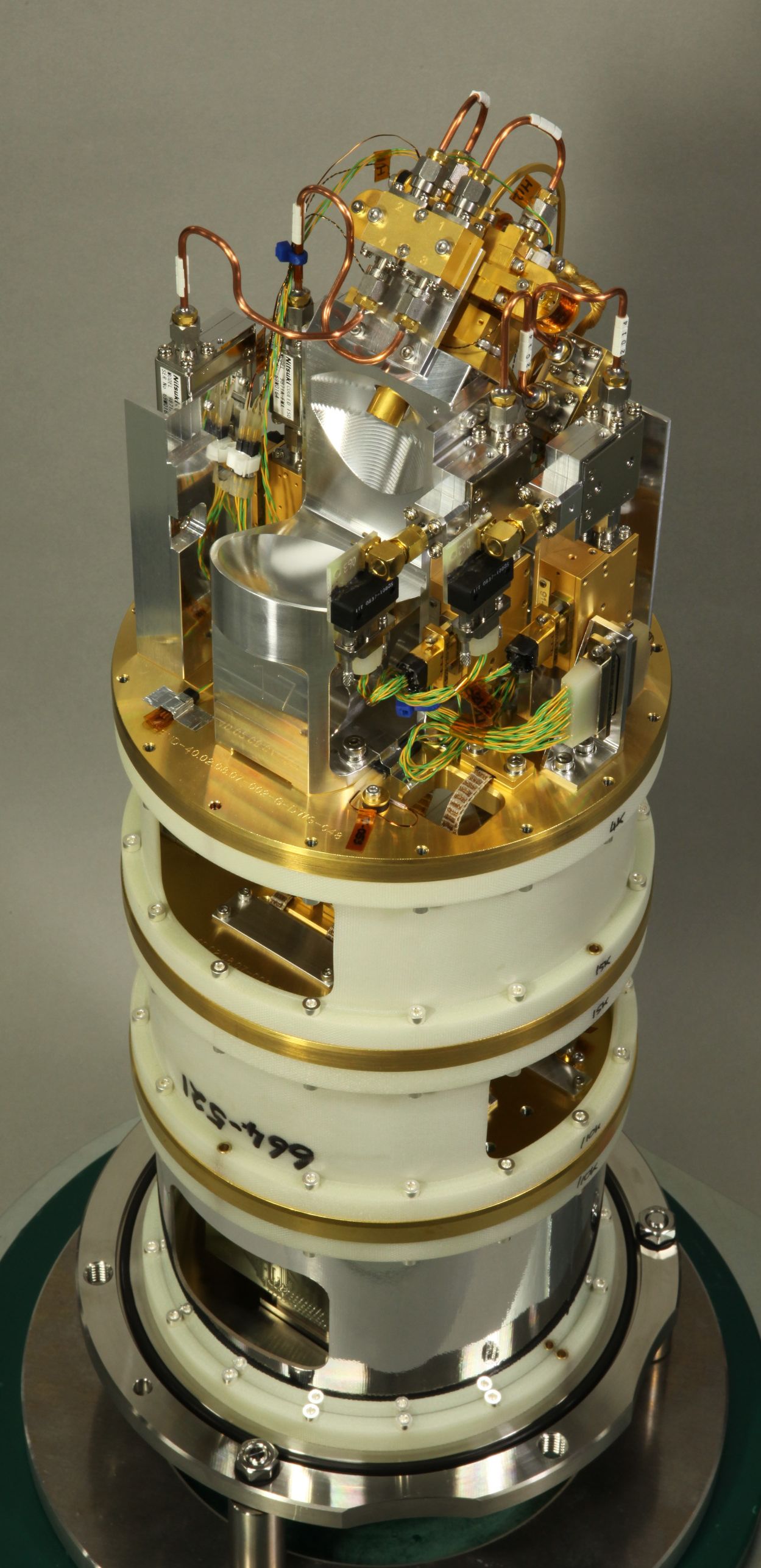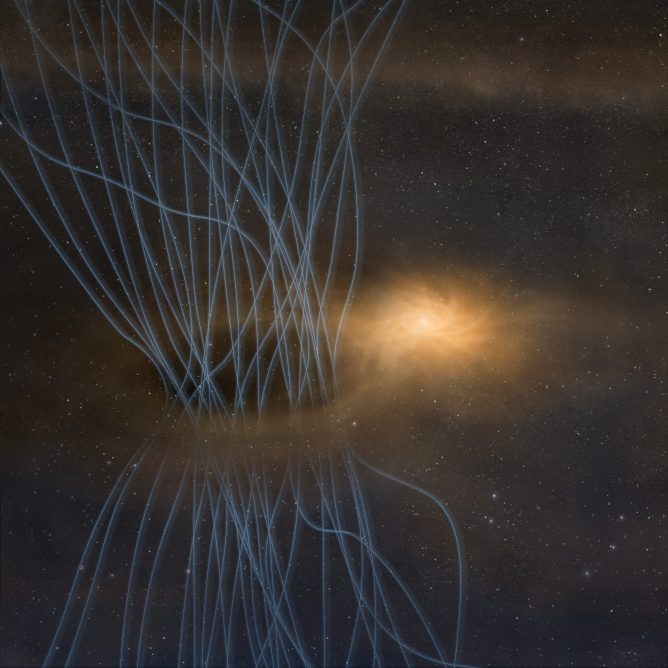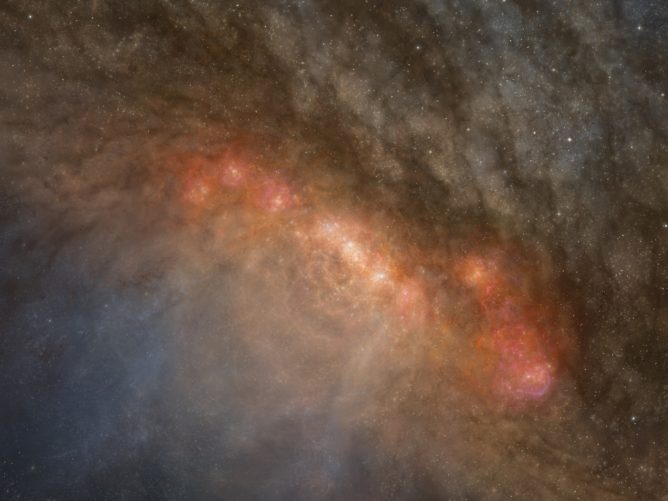ALMA opens another window to the universe in the 500 GHz frequency band. Astronomers successfully synthesized the distribution of atomic carbon around a planetary nebula NGC 6302 in test observations with the ALMA Band 8 receiver, developed by the National Astronomical Observatory of Japan (NAOJ). This is the first 500 GHz band astronomical image captured by a radio interferometer with unprecedentedly high resolution. (Photo 2)
ALMA has 10 receiver bands to cover a wide range of observing frequency. All antennas are equipped with dedicated receivers for each frequency band. NAOJ assumes the development of three bands: Band 4 (receiving frequency: 125 to 163 GHz, millimeter-wave); Band 8 (385 to 500 GHz, submillimeter-wave); and Band 10 (787 to 950 GHz, Terahertz-wave).
Photo 1. ALMA Band 8 receiver cartridge
The frequency band observable with the Band 8 receiver covers a wide range of radio emission lines from various atoms and molecules. Among them, one of the most attractive targets for many astronomers is the emission from atomic carbon at 492 GHz. What can we expect to see from it?
The main component of the cosmic gas is hydrogen. The abundance of carbon is only 1/3000 of that of hydrogen, although carbon is the third most abundant element in the universe. The cosmic gas can be classified into three groups by its temperature and density; “plasma cloud” (number density of plasma particles: 0.01 per 1 cm3, temperature: several million degrees Celsius), “atomic cloud” (number density of atom: 10 per 1 cm3, temperature: -160 degrees Celsius), and “molecular cloud” (number density of molecule: 10000 per 1 cm3, temperature: – 260 degrees Celsius). Dense regions of atomic cloud grow into molecular cloud, and molecular cloud with increased density becomes a seedbed of stars. On the other hand, molecules composing molecular cloud dissociate into atoms when exposed to intense ultraviolet light. Detailed study of the distributions of atomic cloud and molecular cloud gives us insights into the evolution of cosmic gas. In particular, observation of carbon atom is important not only in studying the distribution and characteristics of atomic cloud, but also in exploring chemistry in the universe because various complex molecules are formed from chemical reactions between carbon atom and other atoms such as oxygen and hydrogen.
So far, observations in the 500 GHz band, including emission line from cosmic carbon atom, have been made with single dish radio telescopes such as the University of Tokyo’s Mt. Fuji Submillimeter Telescope (*1) and Caltech Submillimeter Observatory (CSO, *2). The typical spatial resolution of those observations is 15 arcseconds or larger (1 arcsecond corresponds to 1/3600 of 1 degree), which is far worse than the resolution of existing 8-meter class optical telescopes (0.1 arcsecond). ALMA is the first radio interferometer which allows observations in this frequency range with remarkably improved resolution compared to single dish telescopes. This time, the Band 8 receivers were installed in six 7-m antennas developed by Japan and achieved a high resolution of 3 arcseconds. By installing the receiver into all the ALMA antennas, the resolution becomes even better by 400 times. Astronomers around the world have high expectations for observations with Band 8.
Yutaro Sekimoto, an associate professor at NAOJ and the leader of the Band 8 receiver development team at the NAOJ’s Advanced Technology Center says “I deeply appreciate long and hard efforts of all staff to realize ALMA observation of carbon atom. I expect further ALMA observations will unveil the evolution process of interstellar matter.” Naohisa Sato, a member of the development team, says “We went through difficult times during receiver production phase. We made a number of adjustments and replacements to achieve required performance for every receiver. I am really happy with this successful result.”
NGC 6302 is a planetary nebula, which is in the final stage of the life of a star with a mass several times that of the Sun. Visible light image shows a bipolar shape of gas ejected from the dying star. ALMA with the Band 8 receivers targeted at the center of the nebula and revealed that the distribution of carbon atom is concentrated in a small part, which is similar to a dust and gas disk around the central star that has been found by previous observations with other telescopes. Further observations of carbon atom with better resolution will give us more detailed view of the chemical environment in the nebula.
Note
*1. Mt. Fuji Submillimeter Telescope was a 1.2-m submillimeter telescope at the top of Mt. Fuji, developed and operated by the Department of Physics and Research Center for the Early Universe, The University of Tokyo, in collaboration with the Institute of Molecular Science and NAOJ. After the installation in 1998, the telescope was used for intensive survey observations of carbon atom emission at 492 GHz. It revealed the wide-spread distribution of carbon atom and showed successful results in the research of the formation of molecular clouds.
*2. Caltech Submillimeter Observatory has 10.4-m submillimeter telescope located at the top of Maunakea, Hawaii. It is one of the pioneers in the submillimeter astronomy.
Link
- Jun 24, 2005 Band 8 Preliminary Design Review
- Jun 25, 2009 Band 4 and Band 8 Critical Design Review
- Jul 22, 2011 Band 8 Manufacturing Readiness Review (MRR)
- Mar 28, 2012 Successful Interferometer Test with Band 8 Receiver
- Sep 14, 2012 Successful Interferometer Test with Band 8 Receiver and Three 7-m Antennas
Photo 2. Planetary Nebula NGC 6302. The right image is the composite image of ALMA Band 8 (yellow) and the Hubble Space Telescope (gray). Upper left image is the whole view of NGC 6302 taken by the Hubble Space Telescope, and yellow rectangle corresponds to the right image area. Lower left panel shows the line profile of atomic carbon.
Download the right image.
Credit: ALMA (ESO/NAOJ/NRAO), NASA/ESA Hubble Space Telescope











